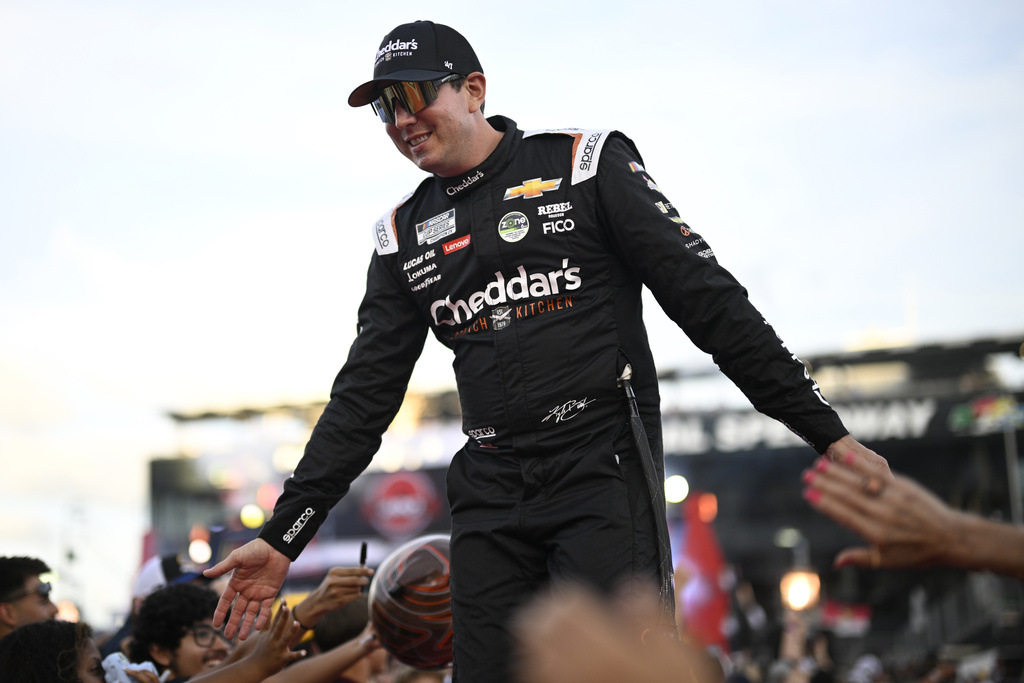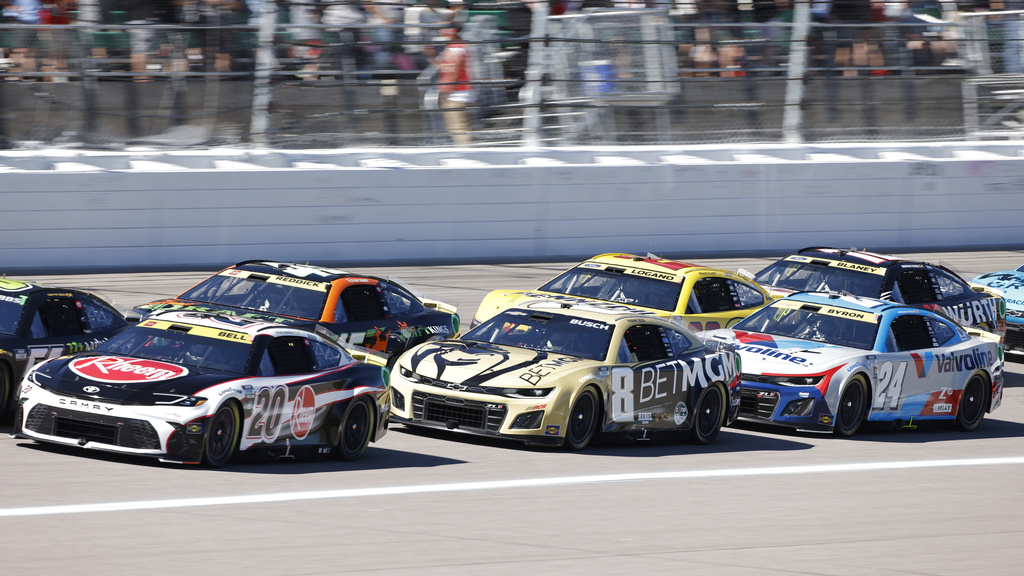NASCAR Returns to Talladega as Legal Dispute Stirs Controversy \ Newslooks \ Washington DC \ Mary Sidiqi \ Evening Edition \ NASCAR returns to Talladega Superspeedway amid a new wave of controversy, with 23XI Racing and Front Row Motorsports filing an antitrust lawsuit against NASCAR. The conflict echoes Talladega’s contentious 1969 debut when drivers boycotted the track. Meanwhile, the racing focus shifts between playoff hopes, pole wins, and new aerodynamic updates for safety.

NASCAR Legal Battle at Talladega Quick Looks
- History of Dispute: Talladega, site of the 1969 driver protest, is again a focal point of conflict.
- Antitrust Lawsuit: 23XI Racing and Front Row Motorsports sue NASCAR over the charter system.
- Pole Winner: Michael McDowell takes his fifth superspeedway pole, starting at the front for Talladega.
- Driver Reactions: Denny Hamlin and Tyler Reddick remain focused despite team lawsuits.
- New Safety Measures: NASCAR introduces aerodynamic changes to prevent cars from going airborne.
Deep Look
It seems fitting that NASCAR finds itself racing at Talladega Superspeedway this weekend, the site of a seminal moment in the sport’s history where driver power clashed with NASCAR’s authority. Talladega was where, back in 1969, tensions between drivers and NASCAR founder Bill France Sr. erupted in one of the sport’s first major disputes. Led by Richard Petty, the Professional Driver Association (PDA) declared the track unsafe, asking for the inaugural race to be postponed. Bill France refused, resulting in 36 NASCAR regulars boycotting the event, but the race continued without them, showcasing France’s determination to maintain control over NASCAR’s direction
Fast forward 55 years, Talladega is once again a flashpoint, but this time the challenge comes in the form of a legal dispute. Only two teams, Michael Jordan’s 23XI Racing and Front Row Motorsports, have refused to accept NASCAR’s “take-it-or-leave-it” charter agreement presented just 48 hours before the playoff opener last month. This week, the two teams filed an antitrust lawsuit against NASCAR, claiming the charter system, which outlines the revenue-sharing and ownership structure for teams, is unfair and restrictive.
The lawsuit takes center stage just as NASCAR heads into one of its most intense parts of the season—six races remain in the playoffs, with Sunday’s Talladega race as a critical juncture in the round of 12. Instead of the focus being on who will advance to the next round of playoffs, the conversation around the garage has been dominated by this brewing legal battle.
The Charter System Controversy
The charter system, introduced in 2016, effectively guarantees certain teams entry into each race and a share of the revenue, thereby providing financial stability and a sense of ownership within the sport. However, the recent controversy began when NASCAR handed out a 100-plus-page charter agreement to team owners late in the evening on September 6, with a deadline of midnight to sign or risk losing their charters. Richard Childress, a Hall of Fame team owner, confirmed that his team had no choice but to sign under pressure due to the potential impact on his business. With over 400 employees relying on Richard Childress Racing (RCR), and numerous contracts at stake, he felt compelled to agree despite concerns over the rushed nature of the new terms.
The issue, according to 23XI Racing and Front Row Motorsports, lies in the lack of negotiation and the monopolistic structure that leaves little room for teams to advocate for their interests. Denny Hamlin, who co-owns 23XI Racing alongside NBA legend Michael Jordan, insists that the lawsuit will not distract him from his racing goals. Hamlin, a three-time Daytona 500 winner and a two-time winner at Talladega, remains fiercely motivated to win his first Cup Series championship, currently ranked fifth in the standings.
Driver Focus Amid Legal Battles
Hamlin’s determination was clear on Saturday when he addressed the media, emphasizing his desire to win at Talladega despite the off-track turmoil. “Make no mistake, the competitor in me—you don’t think I don’t want to come out here and win this weekend more than any?” Hamlin said, displaying the same competitive fire that has defined his career. He stressed that adversity only fuels him more, referencing his hatred of losing and his commitment to performing at his best in moments of high pressure.
Meanwhile, Tyler Reddick, another key driver for 23XI Racing, is facing challenges of his own as he enters the race below the playoff elimination cutline. Despite winning at Talladega in the spring as part of his run to the regular-season championship, Reddick has struggled during the current playoffs. His average finish in the first four races has been 19th, and he has collected only one top-10 finish. As he heads into Sunday’s race, Reddick acknowledged the team’s struggles, calling the recent performance a “head-scratcher.” He vowed to approach Talladega as he normally would, dismissing any concern that NASCAR’s scrutiny could affect his performance because of the legal dispute.
Pole Position and Superspeedway Success
On the track, Michael McDowell of Front Row Motorsports took the spotlight by winning the pole at Talladega. It marked his fifth superspeedway pole of the season, continuing his strong qualifying performances on these tracks. McDowell, although not a playoff contender this season, has emerged as a qualifying powerhouse, securing poles at major events like Atlanta Motor Speedway and both Talladega races. His lap of 183.063 mph topped the qualifying session, leading to a Ford sweep with Austin Cindric of Team Penske qualifying second and Todd Gilliland, McDowell’s teammate, starting third.
Notably, Kyle Busch of Richard Childress Racing, who is fighting to keep his streak of winning at least one race per year for 20 consecutive seasons, qualified fourth. Reigning Cup Series champion Ryan Blaney was fifth, followed by Penske teammate Joey Logano and Austin Dillon, another RCR driver. Denny Hamlin led the Toyota group, qualifying eighth, as the playoff contenders set their sights on securing spots in the next round.
Aerodynamic Changes for Safety
Safety has also taken a front seat this weekend, with NASCAR implementing a new aerodynamic package designed to prevent cars from becoming airborne. The update comes after multiple incidents over the past few weeks, including Josh Berry flipping at Daytona International Speedway and Corey LaJoie flipping at Michigan International Speedway. The new parts include an added rocker skirt on the side of the cars and modifications to the right-side roof flap, extending its roof rails by two inches and reinforcing the fabric on the inside. These changes aim to increase the threshold at which cars lift off during high-speed accidents, particularly at superspeedways like Talladega, which features the highest banking in NASCAR at 33 degrees and stretches for 2.66 miles.
Historical Context and Modern Echoes
The irony of this weekend’s setting at Talladega is not lost on long-time fans of the sport. In 1969, the Alabama track became the site of one of NASCAR’s first major internal conflicts when drivers, led by Richard Petty and the PDA, argued that the track was unsafe due to tire failures and high speeds. When Bill France refused to postpone the race, 36 drivers walked away, leaving the field largely comprised of amateur and less experienced drivers. France’s decision to press ahead without the top competitors of the day was a defining moment for NASCAR, underscoring his absolute authority over the sport.
The current lawsuit may not involve a driver walkout, but it once again pits team interests against NASCAR’s leadership. The outcome could fundamentally reshape the way revenue and power are distributed within the sport, much like the showdown in 1969 set the tone for the relationship between drivers and NASCAR management for years to come. This is, as Kyle Larson remarked, “one of the biggest stories in a long time,” and it carries significant implications for the future of NASCAR’s ownership and competition model.
Future at Stake
As NASCAR grapples with this legal challenge, the atmosphere around the Talladega garage is a mix of anticipation and uncertainty. The playoff battles are fierce, but the ongoing lawsuit looms large, overshadowing much of the excitement typically associated with this stage of the season. How NASCAR navigates these dual challenges—both the on-track competition and the off-track legal confrontation—will likely determine the trajectory of the sport’s governance and the power dynamics between its key stakeholders.
NASCAR Returns NASCAR Returns NASCAR Returns NASCAR Returns







